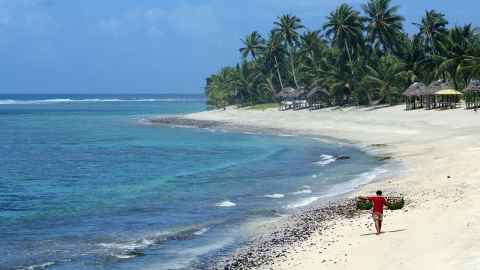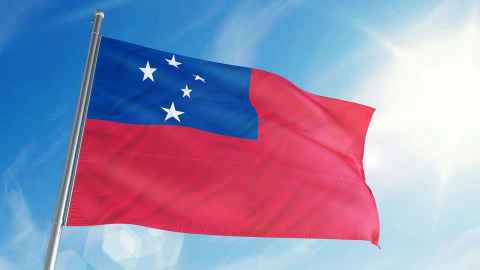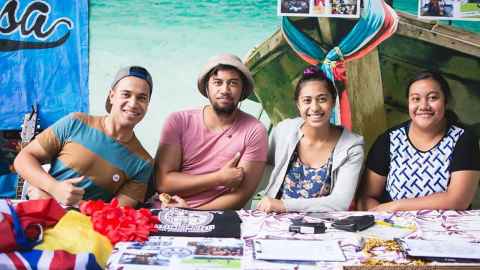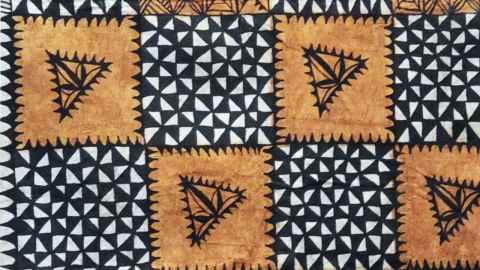Language, identity and 'real' Samoans
27 May 2020
Opinion: The issue of language and identity haunts all Sāmoans who were raised in New Zealand, writes Patrick Thomsen.

I remember the day vividly. I was barely five years old, sitting in the departure lounge at Auckland International Airport with my mother, clutching the flowers that we were taking back to Sāmoa for my grandparents’ graves. Mum tells me that we were leaving the week after my estranged father had suddenly passed away.
It was 1989. I’d just finished at Ngā Iwi kindergarten in Māngere and would start school at St Anne’s in Manurewa when we returned.
We were going to Sāmoa because Mum needed to get some immigration documents for a relative so they could apply for their citizenship in New Zealand. There was no email back then, calling Sāmoa from New Zealand cost an arm and a leg, and, if you know anything about Sāmoa, you know that when you want things done, it’s best to go in person.
We landed at Faleolo airport on a wet, steamy Sāmoan night. And, as we were coming down the stairs of the plane, I remember taking two steps and unceremoniously falling to the very bottom. After this rather traumatic introduction to my ancestral home, I was relieved to find that the flowers for my grandparents were magically still intact. I took great pride in placing them on their graves in front of our family home in Vaimoso.
I have happy memories of that trip to Sāmoa. Mum recalls how I ran under the coconut trees as the men were trying to cut down coconuts for us, while she screamed for me to get out of the way. One rogue coconut falling like a missile on my head could have ended my story right there.
Thankfully for me, it didn’t end there. That trip was the first of many that I would make between Sāmoa and Auckland, almost every year throughout my life.
What is central to the Sāmoan self is an ability to relate to others in respectful ways. To tautua, or serve, your family, your community, and our people.
The one ‘right way’ to be Sāmoan?
But it was when I became a teenager that I began to question what it meant for me to be Sāmoan in this global world.
I was blessed that Sāmoan was always spoken in my house. It meant that I was one of the few in my class who spoke both English and Sāmoan confidently. But I noticed that those who didn’t speak Sāmoan so well would make fun of the kids who could speak Sāmoan but whose English wasn’t perfect.
The issue of language and identity haunts all Sāmoans who were raised in New Zealand. I know this because of the recurring conversation on social media around whether you can call yourself a “real” Sāmoan if you don’t speak the language.
It’s a touchy subject, and I think that’s why so many are quick to weaponise it against others in emotional debates around Sāmoan identity.
What this comes down to is the idea that there’s only one “right way” to be Sāmoan — and that being Sāmoan means looking and behaving and speaking in a certain way.
But life isn’t that simple.
If you’re growing up in Sāmoa, your context will be different from a Sāmoan growing up anywhere else in the world. And I want to say that’s totally okay.
Sāmoans growing up in communities in New Zealand, Australia and the US have developed their own sense of who they are in response to the challenges they face in their overseas homes.
We learn our cultures in relation to those around us, and if you grow up in Aotearoa, you learn who you are as a Sāmoan in relation to what it means to be a New Zealander, all the while navigating your own status as a marginalised Pacific person.
But from this struggle, our people have developed new and beautiful ways to relate to each other. We’ve been influenced by other marginalised groups and express who we are in ways that don’t always match how a sense of the Sāmoan self is expressed in the homeland.
In New Zealand, for example, many Sāmoans are building connections with Māori and supporting their struggles for tino rangatiratanga. That involves us absorbing and learning ways of being that are tika but may appear different from those living in Sāmoa.
We’re building a pan-Pacific identity, too, where we may be Sāmoan, but we’re also Pasifika, which means we’re learning to communicate with other Pacific people in shared dance and songs that are not strictly Sāmoan.
This in no way diminishes the right to a Sāmoan identity. For what is central to the Sāmoan self is an ability to relate to others in respectful ways. To tautua, or serve, your family, your community, and our people.

Language matters . . . but so does context
Language itself is central to understanding one’s culture. How many times do people say that there are some things that simply can’t be translated properly into English? And it’s true. That’s because language is also about expressing context. Embedded within our languages is cultural knowledge specific to the time and place in which it was developed.
The reality though is that learning one’s language is highly dependent on the access we have to it in a living setting.
And because in New Zealand, up until recently, the Sāmoan language has been devalued in Pālagi spaces, a lot of opportunities for generational learning have been missed.
I can’t tell you the number of stories I’ve heard from people whose migrant parents discouraged them from speaking Sāmoan because they believed that concentrating solely on English would guarantee success in New Zealand’s education system.
Judging by the statistics, it’s probably not our lack of command of the English language that’s holding us back.
I think it’s important to realise that the power of the settler-colonial state to devalue and debase Māori, is the same expression of violence that governs us, cousins of the tangata whenua. But we’re not here at our cousins’ request. We’re here mostly because of the needs of the New Zealand economy. We’re here because New Zealand’s factories needed our labour.
Not being able to speak your native tongue can lead to a crisis of confidence for many who are trying to connect back to their gafa (whakapapa).
The persistence of Sāmoan in New Zealand as a widely spoken language despite these challenges is down to the considerable efforts of our church communities (Sāmoan is the third most spoken language in New Zealand after English and te reo Māori, and the second in Auckland).
Those who were raised in a Sāmoan church usually are the ones who’ve managed to keep the language. And many of our a’oga amata (language preschools) are connected to a Sāmoan church.
However, not all of us were raised this way in New Zealand. So I have much sympathy for my fellow Sāmoans who’re here as a result of their forebears’ dreams and aspirations but who can’t speak our language. Almost everyone I know who’s in this position dearly wishes they could.
I don’t, however, share the view that this makes them any less Sāmoan than me. This type of thinking is divisive — and it’s 'lateral violence'. That’s where, instead of directing our energy upward to those in positions of power who subjugate all of us, we lash out sideways, at other people who are in the same category as us.
Like I always say on social media: Punch up, not sideways. And definitely not downwards.
Not being able to speak your native tongue can lead to a crisis of confidence for many who are trying to connect back to their gafa (whakapapa). This is something that is often beyond their control. My nieces and nephews are all 'mixed' Sāmoans who struggle to speak the language.
But I will defend their right to their Sāmoan identity to my very last breath. I’m also putting pressure on my siblings to find ways to teach them Sāmoan, and to show them what makes being Sāmoan beautiful: fa’a’alo’alo, tautua, alofa. Respect, service, love.
At the University of Auckland, I’ve had students who tell me they’re “plastic” and it’s why they’re taking my class — to learn more about their culture. Of course, I assure them that there’s nothing at all plastic about them. It’s sad that so many of our young people are made to feel this way.

Our homeland isn’t frozen in time
I would also discourage any of us from thinking that our homeland is frozen in time and that the Sāmoa of 50 or more years ago, in which 'traditional' Sāmoan ways are forever preserved, is the only way Sāmoan things should be done.
Sāmoan customs have adapted to the pressures of the modern world in innovative ways. You can’t tell me that trading boxes of pisupo and wahoo at fa’alavelave was always a Sāmoan tradition. There’ll be new ways and expressions of the values of fa’a’alo’alo and alofa that may appear different, but it’s the values that underpin the practices that don’t change.
So some of the things you may have learned from those anthropology textbooks shouldn’t be seen as a bible for what a 'real' Sāmoan is. I also share the frustrations of people who live in Sāmoa, and who work to develop and serve Sāmoa, when they see ignorant and patronising critiques of what life in Sāmoa is like.
That Sāmoa is corrupt. That its politicians don’t know what they’re doing. That the standard of education in Sāmoa is not up to par with overseas education. That the villages which still have curfews are backward. That the people are sheep. That we can’t be trusted to look after foreign aid money.
What I’ve seen on my many trips back to Sāmoa (where I stay happily with my family in Vaimoso and Moamoa) is that Sāmoa is a complex, changing, modern nation-state that can think, speak, write, critique, talk, and sing for itself.

Lateral violence can also come in the form of romanticising the homeland. I see this in debates over the way the tatau is practised, in conversations around our government and politics, in the way some of our village customs operate.
With tatau, for example, we get people who criticise tufuga because they use the modern needle gun rather than the traditional ‘au, which means, somehow, that what they produce is “not a real pe’a or malu”. When I visited Sāmoa last and tried to bring this up most of the people I spoke to couldn’t care less. Yet, people here in New Zealand were having near breakdowns on social media trying to explain how it’s “not Sāmoan”.
Sāmoa’s story is a unique one, but it pays to learn it properly,
Like I said, context always matters — and in Sāmoa, humility is golden. In all honesty, I don’t know what a 'real' Sāmoan is yet, despite living as a Sāmoan all my life. Sorry if you thought I had an answer for you.
But what I hope I’ve shared is an optimism in the way forward. That we as migrant Sāmoans, local Sāmoans, as 'part' Sāmoans, can find ways that relate to each other which respects everyone’s unique narrative and mana. One that isn’t mired in reproducing arbitrary, violent, and colonial divisions.
One thing we all share — and I know this to be true — is a love of our homeland, families, and communities. There’s nothing more Sāmoan than that.
Dr Patrick Thomsen is a lecturer in Pacific Studies in the Faculty of Arts.
This article reflects the opinion of the author and not necessarily the views of the University of Auckland.
Used with permission from E-Tangata Identity, language and 'real' Samoans
17 May 2020.
Media contact
Julianne Evans | Media adviser
Mob: 027 562 5868
Email: julianne.evans@auckland.ac.nz